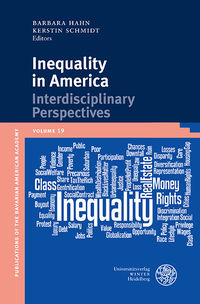
Inequality in America
Interdisciplinary Perspectives
In Co-op. with:
Jasmin Falk
1. Edition, 2017
168 Pages
ISBN: 978-3-8253-7735-9
Product: Ebook
Edition: PDF
Subject: Anglistik/Amerikanistik
Series: Publikationen der Bayerischen Amerika-Akademie / Publications of the Bavarian American Academy, Volume No.: 19
Available: 30.11.2017
Keywords:
Gesellschaft, Politik, Partizipation, U.S.A., 19. Jahrhundert, Demokratie, Lateinamerika, Gesundheitswesen, Armut, Kanada, Kapitalismus, afroamerikanische Literatur, Civil Rights Movement, 20. Jahrhundert, 21. Jahrhundert, Sozialwissenschaft, Ungleichheit, Ethnopolitik, Kommodifizierung, Favelas, Grundbesitz, Chesnutt, Charles, Norris, Bruce, D’Amour, Lisa, Canadian Museum of Human Rights, Black Activism, Klassengesellschaft
In the United States, income inequality has increased significantly. For decades, wage growth has been especially slow for the middle class, whereas the top 10% of earners has benefitted the most from the economic upswing. The same is true for distribution of wealth. According to an analysis by the Pew Research Center, the wealth gap between America’s upper-income and lower-income families has reached its highest level. There are not only disparities between regions of the United States, but also huge differences within American cities themselves that are often caused by urban governance and housing policies. All this is true for Canada and other countries of the Americas as well, but to differing degrees.
By the same token, racial and ethnic inequalities, as well as inequalities along gender lines, leave a deep mark on different countries of the Americas and are often the result of a lack of social justice, equality of opportunity, or access to education and health services. This wide range of systemic and structural inequalities is also negotiated in cultural practices, as novels, plays, short stories, or artistic productions thematize differences between individuals and groups of society, often along the 'color line.'
The essays collected in this book address inequality in America from a variety of perspectives, ranging from literary and cultural studies, sociology, economics, political science, history, geography, as well as museum studies.
Contrib. by: Barbara (Geographie) Hahn, Kerstin Schmidt, Colin Gordon, Susanne Pickel, Lisa Keister, Axel R. Schäfer, David Wilson, Eberhard Rothfuß, Julia Faisst, Shirley Elizabeth Thompson, Rinaldo Walcott, Jodi Giesbrecht
""
Mel van Elteren in: The Journal of American Culture, 41.3 (2018), 328-330
Inhalt (PDF 455kB)




